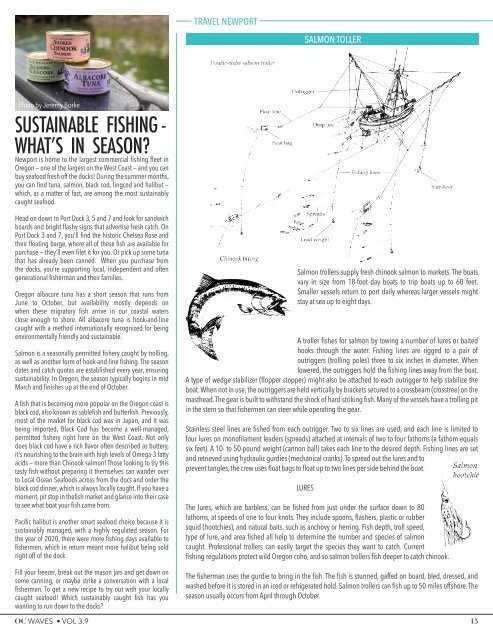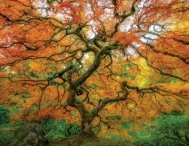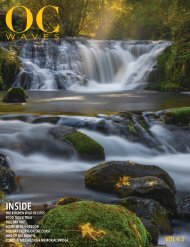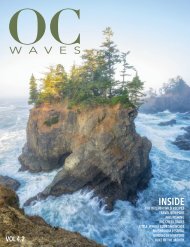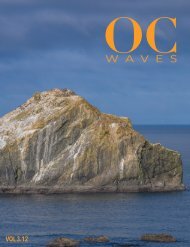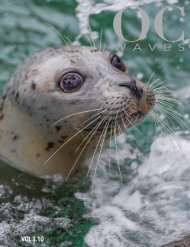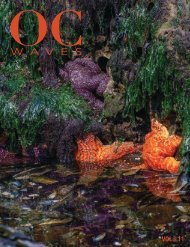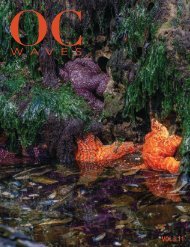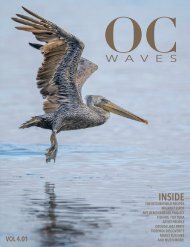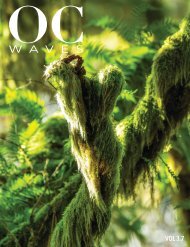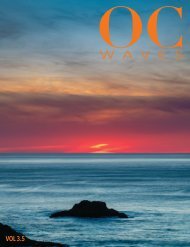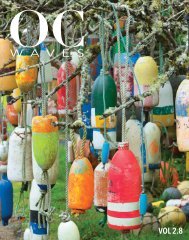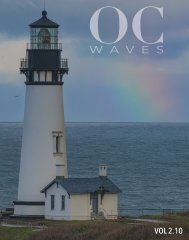Create successful ePaper yourself
Turn your PDF publications into a flip-book with our unique Google optimized e-Paper software.
TRAVEL NEWPORT<br />
SALMON TOLLER<br />
Photo by Jeremy Burke<br />
SUSTAINABLE FISHING -<br />
WHAT’S IN SEASON?<br />
Newport is home to the largest commercial fishing fleet in<br />
Oregon — one of the largest on the West Coast — and you can<br />
buy seafood fresh off the docks! During the summer months,<br />
you can find tuna, salmon, black cod, lingcod and halibut —<br />
which, as a matter of fact, are among the most sustainably<br />
caught seafood.<br />
Head on down to Port Dock 3, 5 and 7 and look for sandwich<br />
boards and bright flashy signs that advertise fresh catch. On<br />
Port Dock 3 and 7, you’ll find the historic Chelsea Rose and<br />
their floating barge, where all of these fish are available for<br />
purchase — they’ll even filet it for you. Or pick up some tuna<br />
that has already been canned. When you purchase from<br />
the docks, you’re supporting local, independent and often<br />
generational fisherman and their families.<br />
Oregon albacore tuna has a short season that runs from<br />
June to October, but availability mostly depends on<br />
when these migratory fish arrive in our coastal waters<br />
close enough to shore. All albacore tuna is hook-and-line<br />
caught with a method internationally recognized for being<br />
environmentally friendly and sustainable.<br />
Salmon is a seasonally permitted fishery caught by trolling,<br />
as well as another form of hook-and-line fishing. The season<br />
dates and catch quotas are established every year, ensuring<br />
sustainability. In Oregon, the season typically begins in mid<br />
March and finishes up at the end of October.<br />
A fish that is becoming more popular on the Oregon coast is<br />
black cod, also known as sablefish and butterfish. Previously,<br />
most of the market for black cod was in Japan, and it was<br />
being imported, Black Cod has become a well-managed,<br />
permitted fishery right here on the West Coast. Not only<br />
does black cod have a rich flavor often described as buttery,<br />
it’s nourishing to the brain with high levels of Omega-3 fatty<br />
acids — more than Chinook salmon! Those looking to try this<br />
tasty fish without preparing it themselves can wander over<br />
to Local Ocean Seafoods across from the docs and order the<br />
black cod dinner, which is always locally caught. If you have a<br />
moment, pit stop in thefish market and glance into their case<br />
to see what boat your fish came from.<br />
Pacific halibut is another smart seafood choice because it is<br />
sustainably managed, with a highly regulated season. For<br />
the year of 2020, there were more fishing days available to<br />
fishermen, which in return meant more halibut being sold<br />
right off of the dock.<br />
Fill your freezer, break out the mason jars and get down on<br />
some canning, or maybe strike a conversation with a local<br />
fisherman. To get a new recipe to try out with your locally<br />
caught seafood! Which sustainably caught fish has you<br />
wanting to run down to the docks?<br />
<strong>OC</strong> <strong>WAVES</strong> • VOL <strong>3.9</strong><br />
Salmon trollers supply fresh chinook salmon to markets. The boats<br />
vary in size from 18-foot day boats to trip boats up to 60 feet.<br />
Smaller vessels return to port daily whereas larger vessels might<br />
stay at sea up to eight days.<br />
A troller fishes for salmon by towing a number of lures or baited<br />
hooks through the water. Fishing lines are rigged to a pair of<br />
outriggers (trolling poles) three to six inches in diameter. When<br />
lowered, the outriggers hold the fishing lines away from the boat.<br />
A type of wedge stabilizer (flopper stopper) might also be attached to each outrigger to help stabilize the<br />
boat. When not in use, the outriggers are held vertically by brackets secured to a crossbeam (crosstree) on the<br />
masthead. The gear is built to withstand the shock of hard-striking fish. Many of the vessels have a trolling pit<br />
in the stern so that fishermen can steer while operating the gear.<br />
Stainless steel lines are fished from each outrigger. Two to six lines are used, and each line is limited to<br />
four lures on monofilament leaders (spreads) attached at intervals of two to four fathoms (a fathom equals<br />
six feet). A 10- to 50-pound weight (cannon ball) takes each line to the desired depth. Fishing lines are set<br />
and retrieved using hydraulic gurdies (mechanical cranks). To spread out the lures and to<br />
prevent tangles, the crew uses float bags to float up to two lines per side behind the boat.<br />
LURES<br />
The lures, which are barbless, can be fished from just under the surface down to 80<br />
fathoms, at speeds of one to four knots. They include spoons, flashers, plastic or rubber<br />
squid (hootchies), and natural baits, such as anchovy or herring. Fish depth, troll speed,<br />
type of lure, and area fished all help to determine the number and species of salmon<br />
caught. Professional trollers can easily target the species they want to catch. Current<br />
fishing regulations protect wild Oregon coho, and so salmon trollers fish deeper to catch chinook.<br />
The fisherman uses the gurdie to bring in the fish. The fish is stunned, gaffed on board, bled, dressed, and<br />
washed before it is stored in an iced or refrigerated hold. Salmon trollers can fish up to 50 miles offshore. The<br />
season usually occurs from April through October.<br />
15


